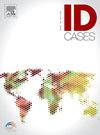Bloodstream infection caused by Erysipelothrix rhusiopathiae serotype 6: Case report and literature review
IF 1
Q4 INFECTIOUS DISEASES
引用次数: 0
Abstract
Erysipelothrix rhusiopathiae is a zoonotic, facultatively anaerobic, non-spore-forming, gram-positive bacillus. Although the serotypes and phylogenetic clades of E. rhusiopathiae strains isolated from animals have been shown to be closely related, the serotype identification of clinical isolates from human patients remains limited. We report a case of a 66-year-old woman with bacteremia caused by E. rhusiopathiae serotype 6. The patient had been admitted with aspiration pneumonia and heat stroke. She had no animal-related occupational history and had been receiving long-term oral prednisolone therapy for mixed connective tissue disease. Upon confirmation of E. rhusiopathiae positivity on blood cultures, she was treated with intravenous ampicillin for 10 days and achieved complete recovery. Agar gel precipitation and polymerase chain reaction tests identified the isolate as serotype 6. Surface protective antigen (Spa) typing by sequence analysis suggested a marine animal origin of infection. To the best of our knowledge, this is the first reported case of bacteremia caused by E. rhusiopathiae serotype 6 in humans. Spa typing through sequence analysis may provide variable information for identifying the infection source. E. rhusiopathiae carrying the SpaB gene should be considered in immunosuppressed patients, regardless of animal exposure history. Further studies are needed to elucidate the epidemiological distribution of serotypes among human clinical isolates.
6型红喉丹毒致血液感染1例并文献复习
红喉丹毒是一种人畜共患,兼性厌氧,非孢子形成,革兰氏阳性杆菌。虽然从动物中分离出的红脓杆菌菌株的血清型和系统发育分支已被证明密切相关,但从人类患者中分离出的临床分离株的血清型鉴定仍然有限。我们报告一个病例66岁的妇女与细菌血症引起的咳脓杆菌血清型6。病人因吸入性肺炎和中暑入院。她没有动物相关的职业史,一直接受长期口服强的松龙治疗混合性结缔组织病。经血培养确认为红脓杆菌阳性后,患者静脉注射氨苄西林10天,完全康复。琼脂凝胶沉淀和聚合酶链反应试验鉴定该分离物为血清型6。表面保护性抗原(Spa)序列分型提示感染源为海洋动物。据我们所知,这是第一例由6型鼻热杆菌引起的人类菌血症报告。通过序列分析进行Spa分型可为确定传染源提供可变信息。无论动物暴露史如何,免疫抑制患者应考虑携带SpaB基因的rhusipathae。需要进一步的研究来阐明人类临床分离株血清型的流行病学分布。
本文章由计算机程序翻译,如有差异,请以英文原文为准。
求助全文
约1分钟内获得全文
求助全文

 求助内容:
求助内容: 应助结果提醒方式:
应助结果提醒方式:


